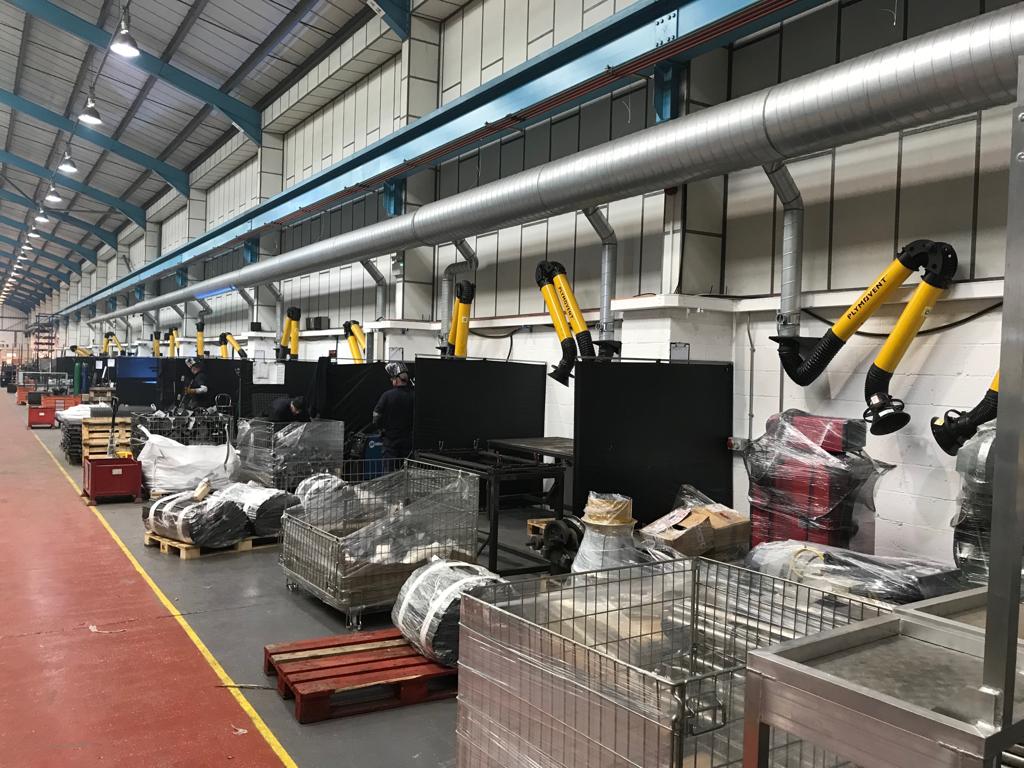Why Identifying Contaminants Matters
Different work processes release very different pollutants, each of which demands a specific capture hood, airflow and filter media. Before an LEV can be designed or tested, you must know exactly what you are trying to remove – otherwise you risk under-engineering the system and leaving staff unprotected.
1. Dusts – the visible and invisible particles
Dusts are solid particles produced by mechanical action (cutting, sanding, crushing) or by handling powders. Their size determines where they lodge in the respiratory tract: coarse dust irritates the nose and throat, while respirable fractions (≤ 5 µm) penetrate deep into the lungs and may cause chronic obstructive pulmonary disease or silicosis. Typical workplace dusts include:
- Wood dust – carpentry, joinery and MDF machining
- Respirable crystalline silica – stone cutting, tile manufacturing
- Flour and grain dust – bakeries, animal feed plants
- Composite and fibreglass dust – boat-building, wind-turbine production
LEV hoods with enclosure or close-capture design and high-efficiency filters (e.g. H Class) are required to control these particles.
2. Metallic fumes and smoke
Fumes are created when metal is heated above its boiling point and the vapour condenses into ultra-fine particles. They are easily inhaled and – in the case of mild-steel welding – classified as a Group 1 carcinogen. Processes generating fumes include:
- Manual and robotic welding
- Thermal cutting and plasma/laser profiling
- Soldering and brazing
HSE guidance now requires on-torch or downdraught LEV for all indoor welding to capture fume at source and protect both the welder and nearby staff.
3. Vapours and gases
Solvents, adhesives, paints, cleaning chemicals and various production gases give off vapours that can cause dizziness, organ damage or fire and explosion if allowed to accumulate. Carbon monoxide from gas-fired plant and nitrogen oxides from combustion processes are common gaseous hazards. Because vapours behave like the air that carries them, LEV requires sufficient capture velocity at the point of emission (spray booth slot, mixing vessel lid, fume cupboard) and may need activated-carbon filtration in addition to particulate arrest.
4. Mists and aerosols
Mists are liquid droplets formed by atomising or splashing. Metal-working fluids, coolant oils, spray-painting overspray and disinfectant fogging all fall into this category. Chronic exposure is linked to extrinsic allergic alveolitis and occupational asthma. LEV solutions range from fully-enclosed CNC machines with mist collectors to downdraught benches fitted with coalescing filters.
5. Biological contaminants
Where work involves biological agents – laboratories, composting sites, pharmaceutical production – LEV is used to contain spores, bacteria and viruses at source before they become an inhalation risk. In most cases this is achieved through Class I–III safety cabinets or negative-pressure enclosures exhausted through HEPA filtration.
Beyond capture: legal and practical benefits
Removing contaminants with a correctly specified LEV system:
- Keeps exposure below WELs and demonstrates compliance with COSHH Reg 9
- Reduces absenteeism associated with respiratory and dermatological illness
- Protects sensitive equipment and finished products from contamination
- Lowers housekeeping costs and combustible-dust fire risks
- Cuts energy use by extracting only contaminated air rather than whole-room volumes
All LEV systems must be thoroughly examined and tested at least once every 14 months, with any defects rectified promptly to maintain performance.
Final thoughts
Whatever contaminants your process releases – dust, fume, vapour, mist or biological agents – a well-designed Local Exhaust Ventilation system is the most reliable way to capture them before they reach your workers’ breathing zone. If you’re unsure what hazards you need to control, our engineers can carry out an on-site survey, identify the contaminants and recommend a compliant, energy-efficient solution.
Contact LEV Engineering today to discuss your requirements and protect your workforce.

